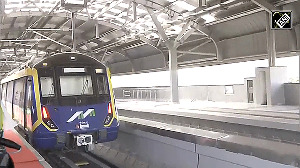After the favourable monsoons at 105% of the long period average last fiscal, which led to an equally strong growth in agriculture & allied sectors (9.6% YoY) and consequently aided the 8.5% GDP growth, the erratic monsoon pattern during FY05 is likely to have some adverse impact on agricultural production.
It must be noted that though agriculture accounts for only about 25% of the country's GDP, the huge dependence of Indian population (approx. 65%) on this sector for a livelihood signifies the importance of this sector.

Uneven monsoons - Affecting growth
While as per the long period average, the monsoons were at 87% of normal, the deficient rainfall from the southwest monsoons and its uneven pattern is likely to adversely impact the kharif foodgrains production in the current fiscal.
As a result, the government has estimated that the total foodgrains production will decline marginally by about 2.6% from last year's levels of 212 m tonnes. However, the agriculture & allied sectors combined is expected to end the fiscal with 1.1% growth, thus aiding the economy to achieve the estimated 6.9% growth.
Further, the government continues to pursue its efforts on the irrigation front with the help of its Accelerated Irrigation Benefits Programme (AIBP) launched in FY97.
This had led to the potential area under irrigation increasing by 2.7 m hectares at the end of FY04. It must be noted that for the current fiscal also, the government had provided Rs 28 bn for the AIBP during its previous budget.

Agriculture credit -- Positive signs
There has been a steady increase of credit to the agriculture sector over the last few years as can be seen in the graph above.
Further, it must be noted that having seemingly realised the importance of the agriculture sector for our economic growth and the importance of making available adequate credit support, the government had announced various initiatives during the previous budget, which included the doubling of agricultural credit in 3 years.
Thus, during FY05 as yet, the agriculture credit during 9mFY05 is only marginally lower (at Rs 857 bn) compared to the whole of FY04 (Rs 870 bn) and is all set to surpass previous years credit. Further, on the Kisan Credit Card Scheme front, a total of 43.5 credit cards were issued with the cumulative credits amounting to over Rs 1.1 trillion as at the end of 1HFY05.

Agriculture investment - need of the hour
The share of agriculture sector's capital formation in GDP had been on a decline continuously from 1.92% in the early 1990's to 1.24% in FY02.
Further, the low share of public investment in agriculture continues to remain a concern, though the last couple of years have witnessed some sort of a trend reversal.
This was seemingly owing to the fact that a large proportion of public expenditure was for current expenditure in the form of increased level of subsidy for food and other agricultural inputs rather than creation of assets.
Annual investment in agriculture was Rs 135 bn in FY94, one third of which was public investment. In FY04, it has gone upto Rs 205 bn but the share of public investment has dropped to 26 per cent. It must be noted that during the last half-a-decade, agriculture investment as a percentage of GDP has hovered between 1.2% to 1.4%.
Agriculture exports -- Going strong
Agriculture exports increased from $53 bn in FY03 to US% 64 bn during FY04. Further, the strong growth has continued into FY05 also, which is evident from the fact that 1HFY05 has seen agricultural exports to the tune of $36 bn already, which is a 32% growth over the corresponding period last year.
However, as a percentage of total exports, the share of agriculture has been on a decline from 12.8% in FY03 to 11.8% in FY04 and 9.7% in 1HFY05, which could be attributed to a faster growth in the volume of merchandise exports.
Outlook
The erratic and delayed monsoon with uneven distribution pattern has had an adverse impact on agricultural production, which has led to the government lowering its foodgrains production target by 6 m tonnes.
Nonetheless, the growth in agriculture & its allied sectors is being pegged at 1.1% for the current fiscal. While growth has been witnessed on both the fronts i.e. investments and credit in the recent past, and concrete measures are being taken on improving the percentage of area under irrigation, which will help in reducing the dependence on monsoons, a lot still remains to be done.
With nearly 65% of the country's population dependant on agriculture, there is a serious need to improve investments in the sector, which remain at paltry levels of 1.2%-1.3% of GDP.
Development of efficient marketing and exporting networks to make the most of our agricultural advantages needs to be addressed. Further, measures at improving production yields by resolving the issue of fragmented land holdings must be given importance.
We would like to conclude by saying that the services and the industry sector will keep growing at a steady pace. But if there has to be sustainable growth in the agricultural sector, there is a need for better irrigation facilities, better seeds, better machines and better technology for farmers.
While the government has increasingly shown its intent at reforming the agriculture sector, more concrete measures are required to exploit the full potential of this sector.
This is part of Equitymaster's Budget 2005-06 series. Equitymaster.com is one of India's premier finance portals. The Web site offers a user-friendly portfolio tracker, a weekly buy/sell recommendation service and research reports on India's top companies.








 © 2025
© 2025